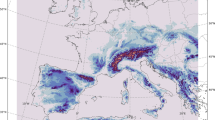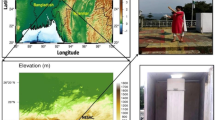Abstract
Accurate determination of the planetary boundary layer (PBL) height (i.e., mixing height (MH)) is critical to properly simulating pollutant levels with the grid-based photochemical models. In this study, the daytime mixing heights based on the parcel and bulk Richardson number methods are compared with those obtained directly from a numerical mesoscale meteorological model in an effort to evaluate the uncertainties in the estimation of the PBL evolution. Mixing heights are estimated from hourly outputs of meteorological variables of the Penn State/NCAR Mesoscale Model Version 3.3 (MM5V3) with two PBL schemes (Blackadar and Gayno-Seaman) during July 1999 over Philadelphia, PA. An analysis of the diurnal variation in the urban PBL and its influence on ground-level ozone (O3) levels is presented in this paper. The results indicate that on average, the MHs determined from the bulk Richardson number were larger than those estimated from the parcel method. The MHs from the MM5V3 output were much smaller than those derived from the parcel and bulk Richardson number methods, especially for the Gayno-Seaman scheme that is based on turbulent kinetic energy. The MH and ground-level O3 concentration have been found to be twice as much on episode days than on non-episode days. The average hourly MH growth rate and O3 tendency (i.e. rate of change in O3) were largest during the morning hours (0700 to 1000 eastern standard time (EST)), suggesting that vertical mixing contributes significantly to the accumulation of ground-level O3 in urban areas in the morning hours.
Similar content being viewed by others
References
Stull, R.B.: 1988, An Introduction to Boundary Layer Meteorology, KluwerAcademic Publishers, Dordrecht.
Rao, S.T., Sistla, G., Ku, J.-Y., Zhou, N. and Hao, W.: 1994,Sensitivity of the Urban Airshed Model to mixing height profile. In: Preprints, Eighth Joint Conference on Applications of Air Pollution Meteorology with A&WMA, Nashville, TN, pp. 162–167, American Meteorological Society, Boston, MA.
Sistla, G., Zhou, N., Hao, W., Ku, J.-Y., Rao, S.T., Bornstein, R., Freedman, F. and Thunis, P.: 1996, Effects of uncertainties in meteorological inputs on Urban Airshed Model predictions and ozone control strategies, Atmos. Environ. 30, 2011–2025.
Melas, D., Abbate, G., Haralampopoulos, D. and Kelesidis, A.: 2000, Estimation of meteorological parameters for air quality management: Coupling of sodar data with simple numerical models, J. Appl. Meteorol. 39, 509–515.
Seaman, N.L.: 2000, Meteorological modeling for air-quality assessments, Atmos. Environ. 34,2231–2259.
Seibert, P., Beyrich, F., Gryning, S.-E., Joffre, S., Rasmussen, A. and Tercier, P.:2000, Review and intercomparison of operational methods for the determination of the mixing height, Atmos. Environ. 34, 1001–1027.
Biswas, J. and Rao, S.T.: 2001, Uncertainties in episodicozone modeling stemming from uncertainties in the meteorological fields, J. Appl. Meteorol. 40, 117–136.
Sistla, G., Hao, W., Ku, J.-Y., Kallos, G., Zhang, K., Mao, H. and Rao, S.T.: 2001, Anoperational evaluation of two regional-scale ozone air quality modeling systems over the eastern United States, Bull. Amer. Meteorol. Soc. 82, 945–964.
Zhang, J., Rao, S.T. and Daggupaty, S.M.: 1998,Meteorological processes and ozone exceedances in the northeastern United States during the 12–16 July 1995 episode, J. Appl. Meteorol. 37, 776–789.
Zhang, J. and Rao, S.T.: 1999, The role ofvertical mixing in the temporal evolution of the ground-level ozone concentrations, J. Appl. Meteorol. 38, 1674–1691.
Berkowitz, C.M., Fast, J.D. and Easter, R.C.: 2000, Boundary layer verticalexchange processes and the mass budget of ozone: Observations and model results, J. Geophys. Res. 105, 14,789–14,805.
Berman, S., Ku, J.-Y. and Rao, S.T.: 1999, Spatial and temporal variation in themixing depth over the northeastern United States during the summer of 1995, J. Appl. Meteorol. 38, 1661–1673.
Zhang, K., Mao, H., Civerolo, K., Berman, S., Ku, J.-Y., Rao, S.T., Doddridge, B., Philbrick, C.R. and Clark, R.: 2001, Numerical investigation of boundary layer evolution and nocturnal low-level jets: Local versus non-local PBL schemes, Environ. Fluid Mech. 1, 171–208.
Grell, G.A., Dudhia, J. and Stauffer, D.R.: 1994, A description of the fifth-generation Penn State/NCAR Mesoscale Model (MM5), NCAR/TN-398+1A, National Center for Atmospheric Research, Boulder, CO.
Blackadar, A.K.: 1979, High resolution models of the planetary boundary layer. In: J. Pfafflin and E. Zeigler (eds.), Advances in Environmental Science and Engineering, pp. 50–85, Gordon and Breach, New York.
Zhang, D. and Anthes, R.A.: 1982, A high-resolution model of the planetaryboundary layer-sensitivity tests and comparisons with SESAME-79 data, J. Appl. Meteorol. 21, 1594–1609.
Gayno, G.A., Seaman, N.L., Lario, A.M. and Stauffer, D.R.: 1994, Forecasting visibilityusing a 1.5-closure boundary layer scheme in a 12-km non-hydrostatic model. In: Tenth Conference on Numerical Weather Prediction, pp. 18–20, American Meteorological Society, Boston, MA.
Philbrick, C.R.:1998, Investigations of factors determining the occurrence of ozone and fine particles in northeastern USA. In: Measurement of Toxic and Related Air Pollutants, pp. 248–260, Air & Waste Management Association, Pittsburgh, PA.
Hanna, S.R. and Yang, R.: 2001, Evaluations of mesoscale models'simulations of near-surface winds, temperature gradients, and mixing depths, J. Appl. Meteorol. 40, 1095–1104.
Marsik, F.J., Fisher, K.W., McDonald, T.D. and Samson, P.J.: 1995, Comparisonof methods for estimating mixing height used during the 1992 Atlanta Field Intensive, J. Appl. Meteorol. 34, 1802–1814.
Berman, S., Ku, J.-Y., Zhang, J. and Rao, S.T.: 1997, Uncertainties in estimatingthe mixing depth – comparing three mixing-depth models with profiler measurements, Atmos. Environ. 31, 3023–3039.
Byun, D.W. and Ching, J.K.S. (eds.): 1999, Science Algorithms of the EPAMODELS-3 Community Multiscale Air Quality (CMAQ) Modeling System, U.S. Environmental Protection Agency, Washington, DC.
Holtslag, A.A.M, Meijgaard, E.V. and DeRooy, W.C.: 1995, Acomparison of boundary layer diffusion schemes in unstable conditions over land, Boundary-Layer Meteorol. 76, 69–95.
Author information
Authors and Affiliations
Rights and permissions
About this article
Cite this article
Athanassiadis, G.A., Rao, S.T., Ku, JY. et al. Boundary Layer Evolution and its Influence on Ground-Level Ozone Concentrations. Environmental Fluid Mechanics 2, 339–357 (2002). https://doi.org/10.1023/A:1020456018087
Issue Date:
DOI: https://doi.org/10.1023/A:1020456018087




